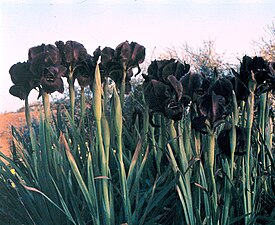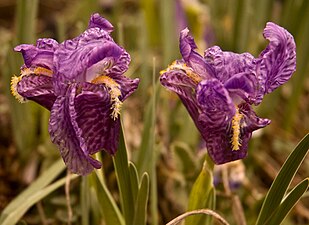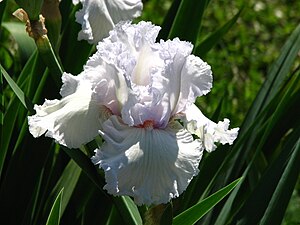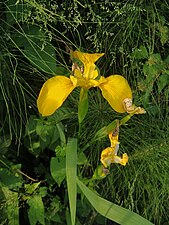Iris (plant)
| Iris | |
|---|---|

| |
| Iris sibirica | |
| Scientific classification | |
| Kingdom: | Plantae |
| Clade: | Tracheophytes |
| Clade: | Angiosperms |
| Clade: | Monocots |
| Order: | Asparagales |
| Family: | Iridaceae |
| Subfamily: | Iridoideae |
| Tribe: | Irideae |
| Genus: | Iris L.
|
| Type species | |
Iris germanica L.
| |
| Subgenera | |
| Synonyms[1][2][3] | |
|
Belamcanda | |
Iris is a
The often-segregated,
Three Iris varieties are used in the Iris flower data set outlined by Ronald Fisher in his 1936 paper The use of multiple measurements in taxonomic problems as an example of linear discriminant analysis.[4]
Description
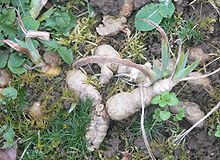
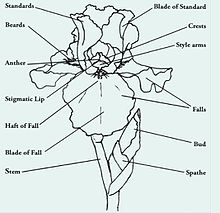
Irises are
Flower
The inflorescences are in the shape of a fan and contain one or more symmetrical six-lobed flowers. These grow on a pedicel or peduncle. The three sepals,[7] which are usually spreading or droop downwards, are referred to as "falls". They expand from their narrow base (the "claw" or "haft"[8]), into a broader expanded portion ("limb" or "blade"[9]) and can be adorned with veining, lines or dots. In the centre of the blade, some of the rhizomatous irises have a "beard", a row of fuzzy hairs at the base of each falls petal which gives pollinators a landing place and guides them to the nectar.[10]
The three,[7] sometimes reduced, petals stand upright, partly behind the sepal bases. They are called "standards". Some smaller iris species have all six lobes pointing straight outwards, but generally limb and standards differ markedly in appearance. They are united at their base into a floral tube that lies above the ovary (This flower, with the petals, and other flower parts, above the ovary is known as an epigynous flower, and it is said to have an inferior ovary, that is an ovary below the other flower parts). The three styles[7] divide towards the apex into petaloid branches; this is significant in pollination.
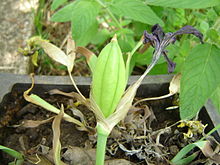
The iris flower is of interest as an example of the relation between flowering plants and pollinating insects. The shape of the flower and the position of the pollen-receiving and stigmatic surfaces on the outer petals form a landing-stage for a flying insect, which in probing for nectar, will first come into contact with the perianth, then with the three[7] stigmatic stamens in one whorled surface which is borne on an ovary formed of three carpels. The shelf-like transverse projection on the inner whorled underside of the stamens is beneath the overarching style arm below the stigma, so that the insect comes in contact with its pollen-covered surface only after passing the stigma; in backing out of the flower it will come in contact only with the non-receptive lower face of the stigma. Thus, an insect bearing pollen from one flower will, in entering a second, deposit the pollen on the stigma; in backing out of a flower, the pollen which it bears will not be rubbed off on the stigma of the same flower.[11]
The iris fruit is a capsule which opens up in three parts to reveal the numerous seeds within. In some species, the seeds bear an aril, such as Iris stolonifera which has light brown seeds with thick white aril.[12]
Etymology
The genus takes its name from the Greek word ἶρις îris "rainbow", which is also the name for the Greek goddess of the rainbow, Iris.[13] Some authors state that the name refers to the wide variety of flower colors found among the many species.[14]
Taxonomy
Iris is the largest
Rodionenko also reduced the number of sections in subgenus Iris, from six to two, depending on the presence (Hexapogon) or absence (Iris) of
In general, modern classifications usually recognise six subgenera, of which five are restricted to the
Evolution
The concept of
Subgeneric division
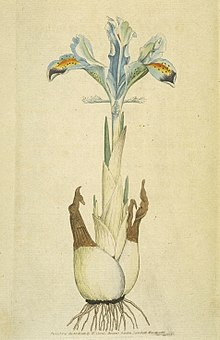
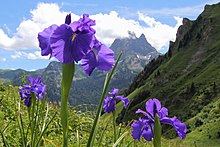
Subgenera
- Iris (Bearded rhizomatous irises)
- Limniris (Beardless rhizomatous irises)
- Xiphium (Smooth-bulbed bulbous irises: Formerly genus Xiphion)
- Nepalensis (Bulbous irises: Formerly genus Junopsis)
- Juno)
- Hermodactyloides (Reticulate-bulbed bulbous irises: Formerly genus Iridodictyum)
Sections, series and species
Distribution and habitat
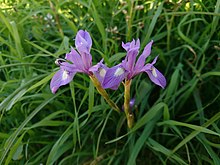


Nearly all species are found in
Diseases
Narcissus mosaic virus is most commonly known from Narcissus.[21][22] Wylie et al., 2014,[22] made the first identification of Narcissus mosaic virus infecting this garden plant genus, and the first record in Australia.[21] Japanese iris necrotic ring virus also, commonly infects this genus.[23] It was, however, unknown in Australia until Wylie et al., 2012,[23] identified it in Australia on I. ensata.[21]
Cultivation
This section needs additional citations for verification. (April 2021) |

Iris is extensively grown as ornamental plant in home and botanical gardens. Presby Memorial Iris Gardens in New Jersey, for example, is a living iris museum with over 10,000 plants,[24] while in Europe the most famous iris garden is arguably the Giardino dell'Iris in Florence (Italy) which every year hosts a well attended iris breeders' competition.[25] Irises, especially the multitude of bearded types, feature regularly in shows such as the Chelsea Flower Show.
For garden cultivation, iris classification differs from taxonomic classification. Garden iris are classed as either bulb iris or rhizome iris (called rhizomatous) with a number of further subdivisions. Due to a wide variety of geographic origins, and thus great genetic diversity, cultivation needs of iris vary greatly.
Generally, Irises grow well in most garden soil types providing they are well-drained, depending on the species.[26] The earliest to bloom are species like I. reticulata and I. reichenbachii, which flower as early as February and March in the Northern Hemisphere, followed by the dwarf forms of I. pumila and others. In May or June, most of the tall bearded varieties start to bloom, such as the German iris and its variety florentina, sweet iris, Hungarian iris, lemon-yellow iris (I. flavescens), Iris sambucina, and their natural and horticultural hybrids such as those described under names like I. neglecta or I. squalens and best united under I. × lurida.
The iris is promoted in the United Kingdom by the British Iris Society.[27] The National Collection of Arthur Bliss Irises is held in Gloucestershire.[28]
The American Iris Society is the International Cultivar Registration Authority for Iris, and recognises over 30,000 registered cultivar names.[29]
Bearded rhizome iris

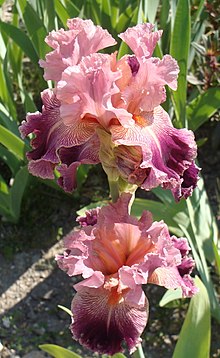
Bearded iris are classified as dwarf, tall, or aril. In Europe, the most commonly found garden iris is a hybrid iris (falsely called
The "beard", short hairs arranged to look like a long furry caterpillar, is found toward the back of the lower petals and its purpose is to guide pollinating insects toward the reproductive parts of the plant. Bearded irises have been cultivated to have much larger blooms than historically; the flowers are now twice the size of those a hundred years ago. Ruffles were introduced in the 1960s to help stabilize the larger petals.[31]
Bearded iris are easy to cultivate and propagate and have become very popular in gardens. A small selection is usually held by garden centres at appropriate times during the season, but there are thousands of cultivars available from specialist suppliers (more than 30,000 cultivars of tall bearded iris). They are best planted as bare root plants in late summer, in a sunny open position with the rhizome visible on the surface of the soil and facing the sun. They should be divided in summer every two or three years, when the clumps become congested.
A truly red bearded iris, like a truly
AGM cultivars
The following is a selection of bearded irises that have gained the Royal Horticultural Society's Award of Garden Merit:
- 'Alizes'[34] (tall bearded, blue & white)
- 'Bumblebee Deelite'[35] (miniature tall bearded, yellow/purple)
- 'Early Light'[36] (tall bearded, pale yellow)
- 'Jane Phillips'[37] (tall bearded, pale blue)
- 'Langport Wren'[38] (intermediate bearded, maroon)
- 'Maui Moonlight'[39] (intermediate bearded, pale yellow)
- 'Orinoco Flow'[40] (border bearded, white/violet)
- 'Raspberry Blush'[41] (intermediate bearded, pink)
- 'Sarah Taylor'[42] (dwarf bearded, pale yellow)
- 'Thornbird'[43] (tall bearded, pale yellow)
- 'Titan's Glory'[44] (tall bearded, deep blue)
Bearded iris Oncocyclus section
This section contains the cushion irises or royal irises, a group of plants noted for their large, strongly marked flowers. Between 30 and 60 species are classified in this section, depending on the authority. Species of section Oncocyclus are generally strict endemics, typically occurring in a small number of scattered, disjunct populations, whose geographical isolation is enhanced by their pollination strategy and myrmecochory seed dispersal. Morphological divergence between populations usually follows a cline reflecting local adaptation to environment conditions; furthermore, this largely overlaps divergence between species, making it difficult to identify discrete species boundaries in these irises.[45][46] Compared with other irises, the cushion varieties are scantily furnished with narrow sickle-shaped leaves and the flowers are usually borne singly on the stalks; they are often very dark and in some almost blackish.[47] The cushion irises are somewhat fastidious growers, and to be successful with them they must be planted rather shallow in very gritty well-drained soil. They should not be disturbed in the autumn, and after the leaves have withered the roots should be protected from heavy rains until growth starts again naturally.
Bearded iris Regelia section
This section, closely allied to the cushion irises, includes several garden hybrids with species in section Oncocyclus, known as Regelio-cyclus irises. They are best planted in September or October in warm sunny positions, the rhizomes being lifted the following July after the leaves have withered.
Beardless rhizome iris (subgenus Limniris)
There are six major subgroupings of the beardless iris, depending on origin. They are divided into Pacific Coast, Siberica, Spuria, Louisiana, Japanese, and other.
Beardless rhizomatous iris types commonly found in the European garden are the
Crested rhizome iris (subgenus Limniris)
One specific species, Iris cristata from North America.
Bulbing juno iris (subgenus Scorpiris)
Often called '
Bulbing European iris (subgenus Xiphium)
This group includes irises generally of European descent, and are also classified as Dutch, English, or Spanish iris.
- Iris reticulata and Iris persica, both of which are fragrant, are also popular with florists.
- Iris xiphium, the Spanish Iris (also known as Dutch Iris) and
- Iris latifolia, the English Iris. Despite the common names both the Spanish and English iris are of Spanish origin, and have very showy flowers, so they are popular with gardeners and florists. They are among the hardier bulbous irises, and can be grown in northern Europe. They require to be planted in thoroughly drained beds in very light open soil, moderately enriched, and should have a rather sheltered position. Both these present a long series of varieties of the most diverse colours, flowering in May, June and July, the smaller Spanish iris being the earlier of the two.
Bulbing reticulate iris (subgenus Hermodactyloides)
Reticulate irises with their characteristic bulbs, including the yellow I. danfordiae, and the various blue-purple I. histrioides and I. reticulata, flower as early as February and March. These reticulate-bulbed irises are miniatures and popular spring bulbs, being one of the first to bloom in the garden. Many of the smaller species of bulbous iris, being liable to perish from excess of moisture, should have a well-drained bed of good but porous soil made up for them, in some sunny spot, and in winter should be protected by a covering of half-decayed leaves or fresh coco-fiber.
Uses
Aromatic rhizomes

Rhizomes of the German iris (I. germanica) and sweet iris (I. pallida) are traded as orris root and are used in perfume and medicine, though more common in ancient times than today. Today, Iris essential oil (absolute) from flowers are sometimes used in aromatherapy as sedative medicines. The dried rhizomes are also given whole to babies to help in teething. Gin brands such as Bombay Sapphire and Magellan Gin use orris root and sometimes iris flowers for flavor and color.[48][49]
For orris root production, iris rhizomes are harvested, dried, and aged for up to 5 years. In this time, the fats and oils inside the roots undergo degradation and
Iris rhizomes also contain notable amounts of
Water purification
In water purification,
In culture
This section needs additional citations for verification. (April 2021) |
The iris has been used in art and as a symbol, including in heraldry. The symbolic meaning has evolved, in Christendom moving from a symbol of Mary mother of Jesus, to a French heraldic sign, the fleur-de-lis, and from French royalty it spread throughout Europe and beyond.
Art

Vincent van Gogh has painted several famous pictures of irises.[53]
The American artist
The artist Philip Hermogenes Calderon painted an iris in his 1856 work Broken Vows; he followed the principles of the Pre-Raphaelite Brotherhood. An ancient belief is that the iris serves as a warning to be heeded, as it was named for the messenger of Olympus. It also conveys images of lost love and silent grief, for young girls were led into the afterlife by the goddess Iris. Broken Vows was accompanied with poetry by Henry Wadsworth Longfellow when it was first exhibited.[54]
Contemporary artist George Gessert, who introduced the cultivation of flowers as an art form, has specialised in breeding irises.[55]
Local varieties as symbol
The Iris croatica is the unofficial national flower of Croatia.[59]
A stylized yellow iris is the symbol of
In 1998, Iris lacustris, the Dwarf Lake iris, was designated the state wildflower of Michigan,[61][62] where the vast majority of populations exist.[63]
In 1990, the Louisiana iris was voted the state wildflower of Louisiana[64] (see also fleur-de-lis:United States, New France), though the state flower is the magnolia blossom.[65]
An iris — species unspecified — is one of the state flowers of
The species Iris versicolor is also the provincial flower of
China
It is thought in China that Iris anguifuga has the ability to keep snakes from entering the garden. It grows all winter, keeping snakes out, but then goes dormant in the spring, allowing the snakes back into the garden. In the autumn, the iris re-appears and can stop the snakes again.[69][70]
Ancient Greece
In the
It has been suggested that the 'agallis' mentioned was a dwarf iris, as described by leaf and root shape,[74]) and identified as Iris attica.[75][76]
Muslim culture
In Iran and Kashmir,
Fleur-de-lis and associated heraldry
French King
The
The red fleur-de-lis in the
Scouting, fraternities & sororities
The fleur-de-lis is the almost-universal symbol of Scouting and one of the symbols adopted by the sorority Kappa Kappa Gamma.
The Iris versicolor is the official flower of Kappa Pi International Honorary Art Fraternity.
Other
The Iris is one of the flowers listed as
Gallery
-
Philip Hermogenes Calderon's Broken Vows with the iris at lower left
-
Early coat-of-arms of the House of Capet (France ancient)
-
Coat-of-arms of Florence
-
Variant on Fransaskois flag
-
Stylized Lily used in heraldry
Gallery
-
Bearded iris cultivar, similar to the classic/historical cultivar 'Alcazar'
-
Chestnut iris cultivars like 'Samurai Warrior' are the closest that breeders have been able to attain to a red bearded iris
-
Iris atropurpurea, a dark flowered, bearded Oncocyclus iris
-
Iris 'Katharine Hodginkin', a bulbous cultivar being a hybrid of I. winogradowii and I. histrioides 'Major'
-
Himalaya
-
Iris 'Sharpshooter' in the Real Jardín Botánico de Madrid, Spain
-
Iris ensata 'Blue Beauty'
-
Iris 'Queen of Angels'
-
Iris 'Blatant'
-
Iris germanica, an old and vigorous cultivar that requires minimal culture
-
Iris 'Mrs. Andris', a vigorous, historic, tall bearded iris cultivar that Fryer hybridized in 1919
-
Wild Iris Spuria in Behbahan
-
Wild Iris Spuria in Behbahan
-
Wild Iris in Mazandaran, Iran
See also
References
- ^ a b c "Iris Tourn. ex L." Plants of the World Online. Board of Trustees of the Royal Botanic Gardens, Kew. 2022. Retrieved 28 September 2022.
- ^ "Iris L." World Flora Online. The World Flora Online Consortium. 2022. Retrieved 28 September 2022.
- ^ "WCSP: Iris". World Checklist of Selected Plant Families. Retrieved 2 June 2014.
- hdl:2440/15227. Archived from the original(PDF) on 2011-04-12. Retrieved 2015-08-30.
- ^ "Iris in Flora of North America @ efloras.org". www.efloras.org. Retrieved 29 September 2022.
- ^ James Cullen, Sabina G. Knees, H. Suzanne Cubey and J. M. H. Shaw (Editors) The European Garden Flora Flowering Plants: A Manual for the Identification ... (2011), p. 241, at Google Books
- ^ OCLC 25708726.
- ^ "Parts of an Iris Flower". merlebleu. Archived from the original on 2016-03-04. Retrieved 28 August 2015.
- ^ Donald Wyman Wyman's Gardening Encyclopedia, p. 574, at Google Books
- ^ Growing Beautiful Bearded Iris Archived 2022-05-20 at the Wayback Machine by Dr. Leonard Perry, University of Vermont
- ^ Pat Willmer Pollination and Floral Ecology, p. 78, at Google Books
- .
- ^ Liddell, Henry George; Scott, Robert (1940). "ἶρις". A Greek-English Lexicon. Perseus Digital Library.
- ISBN 978-0-88192-897-6.
- ^ ISBN 978-1-4398-4924-8.
- ^ "The Genus Iris". mathcs.clarku.edu. Retrieved 29 July 2021.
- ^ ISBN 978-0715305393.
- PMID 19575590.
- ^ "Wild Iris – Iris Setosa – Alaska Wildflower Guide". 21 June 2020. Retrieved 29 September 2022.
- ^ "Stinking iris". Plantlife. Retrieved 29 September 2022.
- ^ S2CID 20506838.
- ^ S2CID 22732571.
- ^ S2CID 43372785.
- ^ Roll, Erin (May 1, 2018). "Everything is coming up irises at Presby". Montclair Local News. Retrieved 24 September 2022.
- ^ "Giardino dell'Iris the most colorful garden of Florence". IntoFlorence. 6 May 2015. Retrieved 24 September 2022.
- ^ "How to grow iris". BBC Gardeners World Magazine. 7 September 2022. Retrieved 22 October 2023.
- ^ "British Iris Society – Promote, improve and extend the cultivation of irises". Britishirissociety.org.uk. Retrieved 10 June 2022.
- ^ "National Collection of AJ Bliss Irises". Blissiris.co.uk. Retrieved 10 June 2022.
- ^ "The American Iris Society Online Iris Register". The American Iris Society. Retrieved 12 October 2023.
- ^ ISBN 978-0881927306.
- ISBN 0-670-03034-1
- ISBN 0-86417-777-1.
Red in the sense that we think of it as pillar box or fire engine red is a colour that is not, as yet, found in iris. There are quite a lot of iris which are loosely described as red but it is a class which, in general, has lacked vigour, been difficult to increase and carry over and particularly difficult to grow in milder climates.
- ^ PMID 23297355.
- ^ "RHS Plant Selector – Iris 'Alizes'". Royal Horticultural Society. Retrieved 22 September 2020.
- ^ "RHS Plant Selector – Iris 'Bumblebee Deelite'". Royal Horticultural Society. Retrieved 22 September 2020.
- ^ "RHS Plant Selector – Iris 'Early Light'". Royal Horticultural Society. Retrieved 22 September 2020.
- ^ "RHS Plant Selector – Iris 'Jane Phillips'". Royal Horticultural Society. Retrieved 22 September 2020.
- ^ "RHS Plant Selector – Iris 'Langport Wren'". Royal Horticultural Society. Retrieved 22 September 2020.
- ^ "RHS Plant Selector – Iris 'Maui Moonlight'". Royal Horticultural Society. Retrieved 22 September 2020.
- ^ "RHS Plant Selector – Iris 'Orinoco Flow'". Royal Horticultural Society. Retrieved 22 September 2020.
- ^ "RHS Plant Selector – Iris 'Raspberry Blush'". Royal Horticultural Society. Retrieved 22 September 2020.
- ^ "RHS Plant Selector – Iris 'Sarah Taylor'". Royal Horticultural Society. Retrieved 22 September 2020.
- ^ "RHS Plant Selector – Iris 'Thornbird'". Royal Horticultural Society. Retrieved 22 September 2020.
- ^ "RHS Plant Selector – Iris 'Titan's Glory'". Royal Horticultural Society. Retrieved 22 September 2020.
- ^ Sapir, Y.; Shmida, A. Species concepts and ecogeographical divergence of Oncocyclus irises. Israel J. Plant Sci. 2002, 50, 119–127
- ^ Abdel Samad, N.; Bou Dagher-Kharrat, M.; Hidalgo, O.; El Zein, R.; Douaihy, B.; Siljak-Yakovlev, S. Unlocking the karyological and cytogenetic diversity of Iris from Lebanon: Oncocyclus section shows a distinctive profile and relative stasis during its continental radiation. PLOS ONE 2016, 15, 11:e0160816. DOI 10.1371/journal.pone.0160816
- doi:10.12705/651.3. Retrieved 4 January 2018.
- ^ Kathi Keville The Aromatherapy Garden: Growing Fragrant Plants for Happiness and Well-Being, p. 397, at Google Books
- ^ "Magellan Gin". Theginisin.com. 2011-01-29. Retrieved 29 May 2018.
- ^ "Iris L., 1753". Gbif.org. Retrieved 2022-05-09.
- ^ David G. Spoerke and Susan C. Smolinske Toxicity of Houseplants, p. 236, at Google Books
- ^ "Yellow Flag Iris". Western New York PRISM. 2014-02-12. Retrieved 2022-05-18.
- ^ Pioch (2002)
- ^ Mancoff (2003): pp. 6, 16
- ^ West [2008]
- ^ "Wildlife and Vegetation". kinghussein.gov.jo. Government of Jordan. Retrieved 2015-05-10.
- ^ Rinat, Zafrir (11 September 2006). "Caution, Iris Ahead!". haaretz.com. Retrieved 25 July 2016.
- ^ Alon TalAll the Trees of the Forest: Israel's Woodlands from the Bible to the Present, p. 260, at Google Books
- ^ James Minahan The Complete Guide to National Symbols and Emblems (2 Volumes), p. 364, at Google Books
- ^ Chancery of the Prime Minister, Kingdom of Belgium [2007]
- ^ "Iris lacustris Nutt". michiganflora.net. Archived from the original on 5 March 2016. Retrieved 9 April 2015.
- ^ "Michigan State Wildflower". Netstate.com. Retrieved 2012-05-14.
- ^ "Michigan Natural Features Inventory" (PDF). Archived from the original (PDF) on 2011-09-29. Retrieved 2012-05-14.
- ISBN 978-0-87805-637-8.
- ^ "Louisiana State Wildflower". statesymbolsusa.org. Retrieved 28 November 2014.
- ^ "State of Tennessee". state.tn.us.
- ^ "18th Annual Iris Festival". Greenecountypartnership.com. Archived from the original on 2012-03-15. Retrieved 2012-03-03.
- ^ (in French) Gouvernement du Québec Emblèmes du Québec – Iris versicolor Archived 2015-07-21 at the Wayback Machine
- ^ "Species and Water Garden Iris". iriscitygardens.com. Retrieved 19 January 2015.
- ^ Kramb, D. (14 September 2004). "Iris anguifuga". signa.org (Species Iris Group of North America). Retrieved 19 January 2015.
- ^ "ἀγαλλίς". lsj.translatum.gr. Retrieved 10 September 2015.
- ^ a b "Flora 1, Plants of Greek Myth". theoi.com. Retrieved 9 September 2015.
- ^ R. P. Winnington-Ingram Sophocles: An Interpretation (1980), p. 116, at Google Books
- ^ Leonhard Schmitz (Editor) The Classical Museum: A Journal of Philology, and of Ancient History and literature, Volume 5 (1848), p. 60, at Google Books
- ^ "Tag Archives: British Iris Society". wiebkerost.com. Retrieved 10 September 2015.
- ^ Umberto Quattrocchi CRC World Dictionary of Medicinal and Poisonous Plants: Common Names, Scientific names, Synonyms and Etymology (2012, p. 128, at Google Books
- ^ "Chapter I Rhizomatous Iris (part 2)". irisbotanique.over-blog.com. Retrieved 20 October 2015.
- ^ Singh, Gurcharan. "Kashmir Iris". flowersofindia.net. Retrieved 22 October 2015.
- ^ British Iris Society (1997) A Guide to Species Irises: Their Identification and Cultivation, p. 38-39, at Google Books
- ^ Trak, Touseef Hussain; Upadhayay, Ravi (April 2015). "Ethnobotanical And Taxonomic Study Of Members of Iridaceae Family of Kishtwar, (Jammu And Kashmir) India" (PDF). International Journal of Pharma and Bio Sciences. 6 (2): 779–793. Archived from the original (PDF) on 2016-08-02. Retrieved 22 October 2015.
- ^ Margaret Grieve A Modern Herbal, Volume 2 (1971), p. 438, at Google Books
- ^ "Birth Month Flower of February – The Iris". 1st in Flowers!.
Bibliography
- Chancery of the Prime Minister, Kingdom of Belgium (2007): Brussels Town Hall. Retrieved November 11, 2007.
- Kamenetsky, Rina; Okubo, Hiroshi, eds. (2012). "Iridaceae". Ornamental Geophytes: From Basic Science to Sustainable Production. CRC Press. p. 24. ISBN 978-1-4398-4924-8.
- Mancoff, Debra N (2003). Flora Symbolica: Flowers in Pre-Raphaelite Art. New York: Prestel Publishing. ISBN 3-7913-2851-4.
- Pioch, Nicolas (2002). Gogh, Vincent van: Irises. Retrieved December 10, 2008.
- Species Group of the British Iris Society (1996). A Guide to Species Irises: Their Identification and Cultivation. Cambridge: Cambridge University Press. ISBN 0-521-44074-2.
- West, Ruth (2008). "George Gessert". Archived from the original on 2006-05-16. Retrieved December 10, 2008.
Taxonomy
- Baker, John Gilbert (2012). "Systematic Treatment of the Genus Iris". American Iris Society.
- Dykes, William Rickatson (1913). The Genus Iris. Cambridge: Cambridge University Press. ISBN 0486230376.
- Harris, Gwenda (2011). "Classification of Irises" (PDF). New Zealand Iris Society. Archived from the original (PDF) on 2018-01-27.
- Mathew, Brian (1989). The Iris. London: BT Batsford. ISBN 978-0713460391.
- Lawrence, George Hill Mathewson (1953). "A Reclassification of the Genus Iris". Gentes Herbarum. 8: 346–371.
- Rodionenko, GI (1987). The Genus Iris L. (Questions of Morphology, Biology, Evolution and Systematics). London: British Iris Society. ISBN 9780901483300. (translation)
- Taylor, JJ (1976). "A reclassification of Iris species bearing arillate seeds". Proceedings of the Biological Society of Washington. 89: 411–420.
- Wilson, Carol (2004). Phylogeny of the genus Iris based on DNA sequence data. Rancho Santa Ana Botanic Garden. Archived from the original on 2014-06-02.
External links
- Joseph Mason's painting – Copper Iris Copper Iris / Louisiana Flag (Iris cuprea) from John James Audubon's Birds of America
- Flora of North America: Iris
- Flora of China: Iris
- Flora of Pakistan: Iris
- Flora of Nepal: Iris
- A web site devoted to Irises, by David Payne-Joyce; includes plates from Dykes (1913).
- The American Iris Society
- Historic Iris Preservation Society
- An extensive website about Iris
- Iris listings at Wild Flowers of Israel
- Iris in Art and Culture
- Gouvernement du Québec Emblèmes du Québec – Iris versicolor Archived 2015-07-21 at the Wayback Machine (French)











